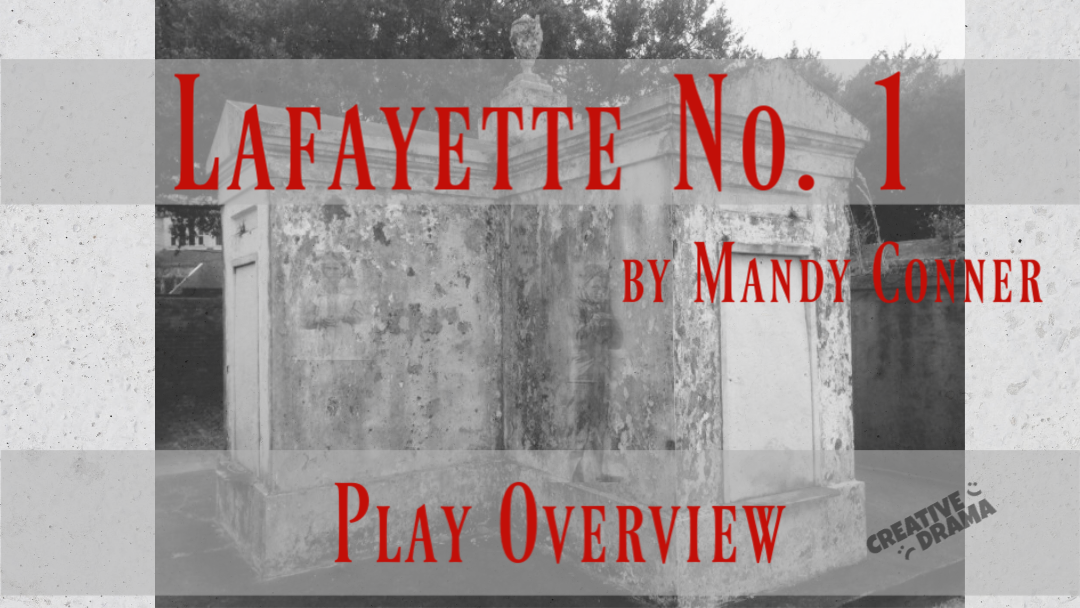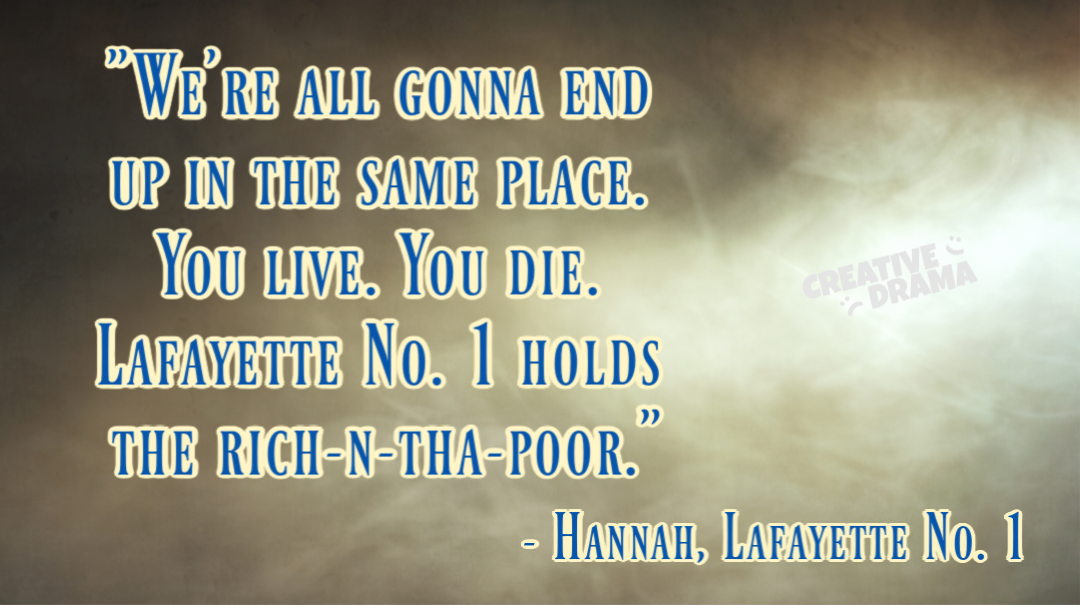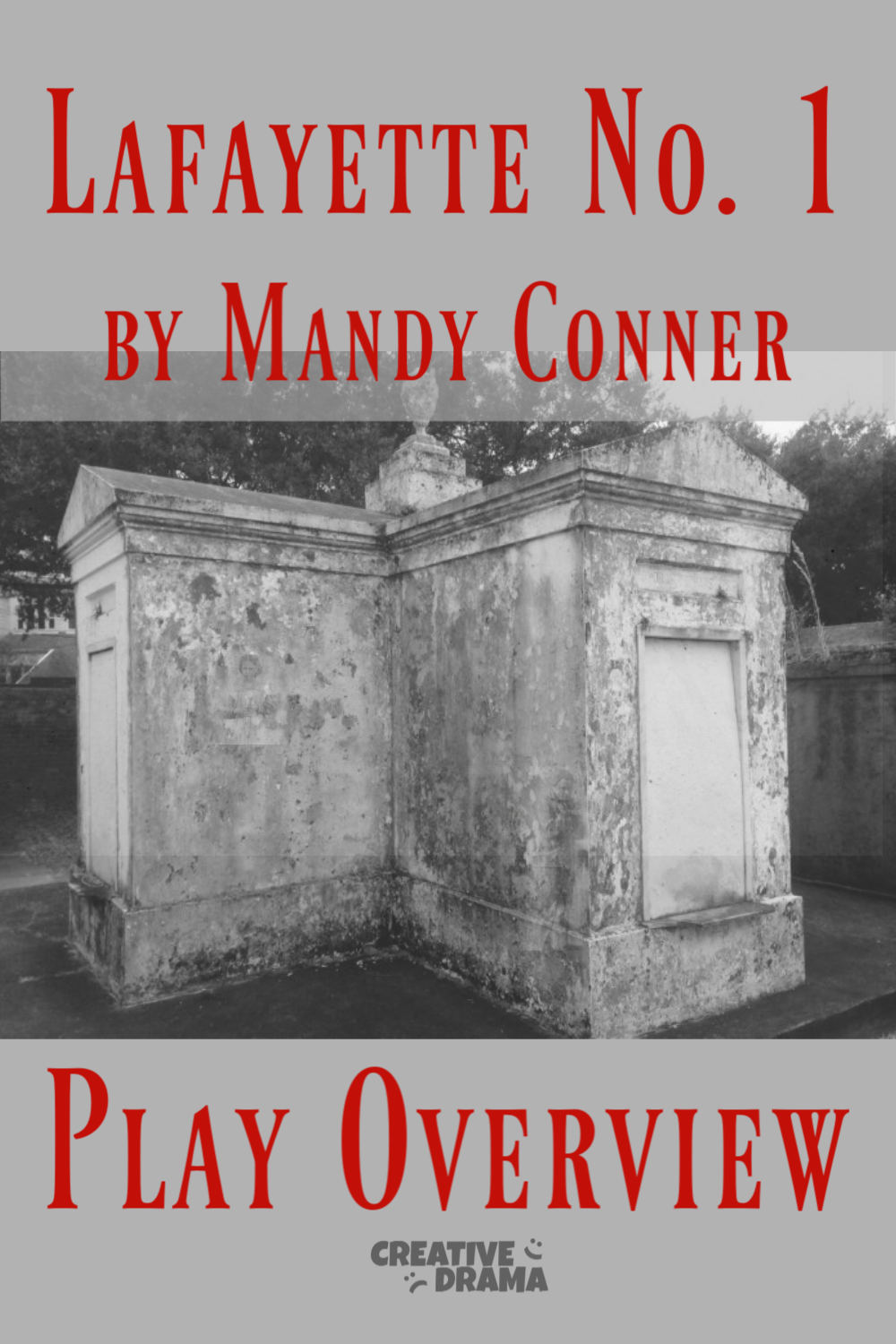Lafayette No. 1 by Mandy Conner – PLAY OVERVIEW

Lafayette No. 1 is a speculative history telling of Julien Poydras’ inspiration to found the Poydras Orphanage, which leads to there being a Poydras Orphans’ Tomb in New Orleans’ Lafayette No. 1 cemetery.
The script is short; estimated performance time in the script is 35-45 minutes, but I think it could be done in 30 – a common time limit for festival and competition one-acts. Lafayette No. 1 has a lot of appeal for competition stages: an historical setting with young adult characters, a social justice issue, personal tragedies, and several roles that could earn accolades for talented, hard-working actors.
THE BASICS
TITLE: Lafayette No. 1
AUTHOR: Mandy Conner
LICENSING ENTITY: Playscripts, Inc.
SUMMARY: In the midst of a yellow fever outbreak, LIZZIE LANDRY helps a group of orphans
CHARACTER BREAKDOWN: 8F (2 Adults, 6 Teenagers); 8M (2 Adults, 6 Teenagers, 1 Indeterminate)
COSTUMES: Period costumes for the early 19th century; there is a 21st century tourist character as well.
SET REQUIREMENTS: The setting is New Orleans in the summer of 1816; interiors (apartment and bakery kitchen) and exteriors (the street, a cemetery with tombs and mausoleums)
PROPS: BREAD!
STAGING CHALLENGES: Fight between two girls; there are ghosts in some dream sequences; staging ten orphans in a polyphonic scene.
BACKGROUND
Lafayette No. 1 premiered at Connally High School in Waco, Texas in 2016. The playwright, Mandy Conner, directed the production.
A trip to New Orleans inspired Mandy Conner to write Lafayette No. 1. She includes real people like Julien Poydras and Margaret Haughery, though their characters are fictionalized. Conner used a list of yellow fever victims to name The Forgotten and Lizzie Landry.
Lafayette No. 1 is the historic cemetery in the Garden District of New Orleans; the city has above-ground tombs and mausoleums since gravesites are prone to flooding.
Epidemics of yellow fever plagued the United States from the 17th through the early 20th Century. New Orleans suffered regular outbreaks; it killed more than 41,000 between 1817 and 1905
THE SCRIPT
The play opens in “the present” with a TOURIST taking photographs of the Orphans’ Tomb.
The next scene establishes that LIZZIE, the daughter of ANNA, has never known her father, and her mother is not willing to divulge much information. ANNA works at a bakery with MS. MARGARET.
At the opening of the play, LIZZIE has an already-established relationship with “The Forgotten,” a group of homeless orphans. She’s been hanging out with them and feeding them scraps from the bakery.
A businessman, POYDRAS, comes along and tells them they’ve got to get out of the neighborhood, because he’s “cleaning up” the city. LIZZIE argues with POYDRAS that he should do something to help get The Forgotten a place to live. But The Forgotten are alternately resigned or determined to change their fate and LIZZIE ends up arguing with HANNAH and HARRIS.
When ANNA dies of yellow fever; MS. MARGARET seems to imply that she will help take care of LIZZIE. But in an offstage moment, MS. MARGARET’s “spinster sister” refuses to let her.
LIZZIE finds herself on the streets with The Forgotten; they bunk down in Lafayette No. 1 for the night. As LIZZIE sleeps, the ghost of ANNA appears to her; ANNA tells her to DO SOMETHING. She convinces The Forgotten to go with her to ask JULIEN to help the orphans once again.
While they are at JULIEN’s residence, HARRIS drops dead, then LIZZIE figures out that POYDRAS is her father. But by the next scene, all the rest of THE FORGOTTEN, including LIZZIE, are dead. POYDRAS is making a proclamation for them to be buried in the Orphans’ Tomb. The Forgotten and LIZZIE speak to the TOURIST again.

PAGE-TO-STAGE
Lafayette No. 1 should be an achievable production for high school students. The play has fairly short scenes throughout and no single character bears a heavy dialogue burden.
This is a chance for your actors to try a Louisiana accent; a good place to start listening is here at the International Dialects of English Archive.
THE CONSTABLE is a very two-dimensional character; he’s listed as a doubled with YELLOW JACK. The role would be good for a beginning actor on its own, or doubled with the symbolic YELLOW JACK if you have an actor with more experience.
The Orphans’ Tomb should not appear onstage; though other tombs and mausoleums should. The stage directions have TOURIST taking a photo of the fourth wall.
The stage directions indicate that ANNA is “showing symptoms of yellow fever throughout” her two scenes. Another character dies of it later in the script. Some of these symptoms appear in later stage directions, but it will be worth it for the actors to investigate how the sickness manifests. (I have a few resources below.)
The dialogue gets overly contemporary at times; for example:
- ANNA calls LIZZIE “sassypants,” but the first recorded use of “sassy” on its own is 1833.
- FINK calls PETER “smarty pants;” the Oxford English Dictionary has 1932 as its earliest appearance.
- “Fancy-schmancy” also first appears in the 1930s.
- “It’s not all about you” shows up twice; it sounds very contemporary (though it may not be).
(These anachronistic phrases are something that most audience members are unlikely to notice; I only noticed it because I read the script multiple times.)
Some of the dialogue might be challenging for actors in terms of discovering their motivations. For example, MARGARET says of The Forgotten: “They are dirty. Who knows what diseases they’re carrying,” followed a few lines later by a criticism of the wealthy: “If they would just spend that money to help these children rather than kick them out.” (There are a few possibilities!)
The actors playing The Forgotten have the opportunity to do some authentic character work. Many of them provide information about their backstories and inner lives. With a little bit of research, the actors could develop fully-realized characters.
CONSIDERATIONS
I’ve assembled a VERY SHORT list of “Considerations” for Lafayette No. 1. This is to help teacher-directors decide if they’d like to get a hold of a perusal copy of a piece for potential performance, or purchase a script for their classroom/department library. The Considerations are aspects of Lafayette No. 1 that, in an ideal universe, wouldn’t cause a problem for a teacher-director. But based on my experience and knowledge of past challenges to educational theatre pieces, these are things that an administrator, parent, member of the public, or a student could potentially object to OR request to change in the script.
DON’T change the script without permission! See this Dramatists Guild initiative for more information.
#dontchangethewords
THE SUPERNATURAL
- All of The Forgotten, LIZZIE, and ANNA appear as ghosts at points in the play.
- YELLOW JACK is the “spirit” of yellow fever, he could come across as a specter of death or a demon.
- There is a reference to “The Voodoo Queen,” Marie Laveau, getting rats and snakes for her rituals in the jail.
LANGUAGE and BEHAVIOR
- LIZZIE and HANNAH have a physical fight.
- The Forgotten toss insults to each other, including ones about physical disabilities and religious beliefs.
- THE CONSTABLE calls The Forgotten “fleas,” “fleabags,” “filthy lice,” and “vermin,” along with other insults.
ROMANCE and SEX
- MOAB has a crush on LIZZIE.
- HARRIS and LIZZIE kiss after a heartfelt conversation.
- LIZZIE is the product of a romance between ANNA and JULIEN; they were not married.
DEATH
- It’s not Titus Andronicus, but 80% of the characters have died of yellow fever by the time Lafayette No. 1 is over.
- Two of the characters die onstage.
THE PLAYWRIGHT
Playwright Mandy Conner is a high school theatre teacher-director from Waco, Texas. She has a Bachelor of Arts in English from Texas Tech University. In 2018, the Texas Educational Theatre Association gave her their Educator of the Year award.
Conner has a second play, Should Not Cause Harm, available through Stage Partners.
OTHER NOTES
Yellow Fever
- NPR has an intriguing article on yellow fever in New Orleans; surviving it gave people social and economic advantages.
- The New Orleans Times-Picayune has “How New Orleans Cured Itself of Yellow Fever.”
- Here’s a recent Q&A with Kathryn Olivarius, an expert in yellow fever in the antebellum South.
Julien Poydras
- Julien Poydras was the founder of The Poydras Orphan Asylum for Females in 1817. He was a scholar and poet as young man, but he soon started working a peddler and eventually became an outrageously successful businessman and plantation owner.
- He never married; there is a legend that the girl he loved was too poor to furnish a dowry. In his will, Poydras left a trust fund for the poor girls of Pointe Coupe and West Baton Rogue parishes so that they would have dowries. The fund was STILL IN OPERATION in West Baton Rogue in 2005; the money goes to the husbands! Conner alludes to the issue of dowries very lightly in Lafayette No. 1.
- Poydras kept enslaved persons and in his will granted them freedom, but only 25 years after his death. He also directed that any enslaved persons be considered “attached” to their plantations and not sold to another owner. There are court petitions here related to Poydras’ will.
- The Poydras Home is still in existence; it’s now a senior citizens’ residence with independent living, assisted living, day care, and Montessori-inspired memory care services.
Margaret Haughery & New Orleans Orphanages
- In addition to being the “Bread Woman.” Margaret Haughery was known as the “Mother of Orphans” in 19th Century New Orleans. A poor widow, she worked and raised funds to help the orphaned children of New Orleans.
- Bayou Preservation restored the Poydras Orphans Tomb in 2016.
- The New Orleans Public Library has a collection of photographs of the Poydras Asylum.
- You’ll find more history on asylums, homes of refuge, and orphanages in New Orleans here.
Here’s some production photographs from a production by L.D. Bell High School’s theatre department.
OTHER PLAYS FEATURING HISTORICAL EVENTS and YOUNG PEOPLE
- Mullen’s Alley by Timothy Mason – A play inspired by the photographs of Jacob Riis, who used his camera and pen to raise awareness of poverty and fight for social reform in late 19th-Century New York. The characters include children from 9 to 15 years old who live in the tenements of Five Points.
- Broken Hallelujah by Sharman Macdonald – Inspired by contemporaneous letters and diaries of young people during the Civil War, the play features teenage characters on both sides of the conflict. The play is available in New Plays from A.C.T.’s Young Conservatory: Volume V.
- Time on Fire by Timothy Mason – Set during the American Revolution, the young adult characters include an enslaved couple, a spy for the British, and a drummer in the Continental Army.
- Who? By Michael Scanlan – Fictional protagonist but real-life tragedy: the stampede at The Who’s 1979 concert in Cincinnati. It’s available in Scanlan’s 3-play collection, Inside/Out.
- The Shape of the Grave by Laura Lundgren Smith – In Northern Ireland during The Troubles, Colleen has some adult decisions to make.
- There’s a comedic take on history in A Simpler Time, a collection of nine plays by nine different playwrights set in nine different time periods.






